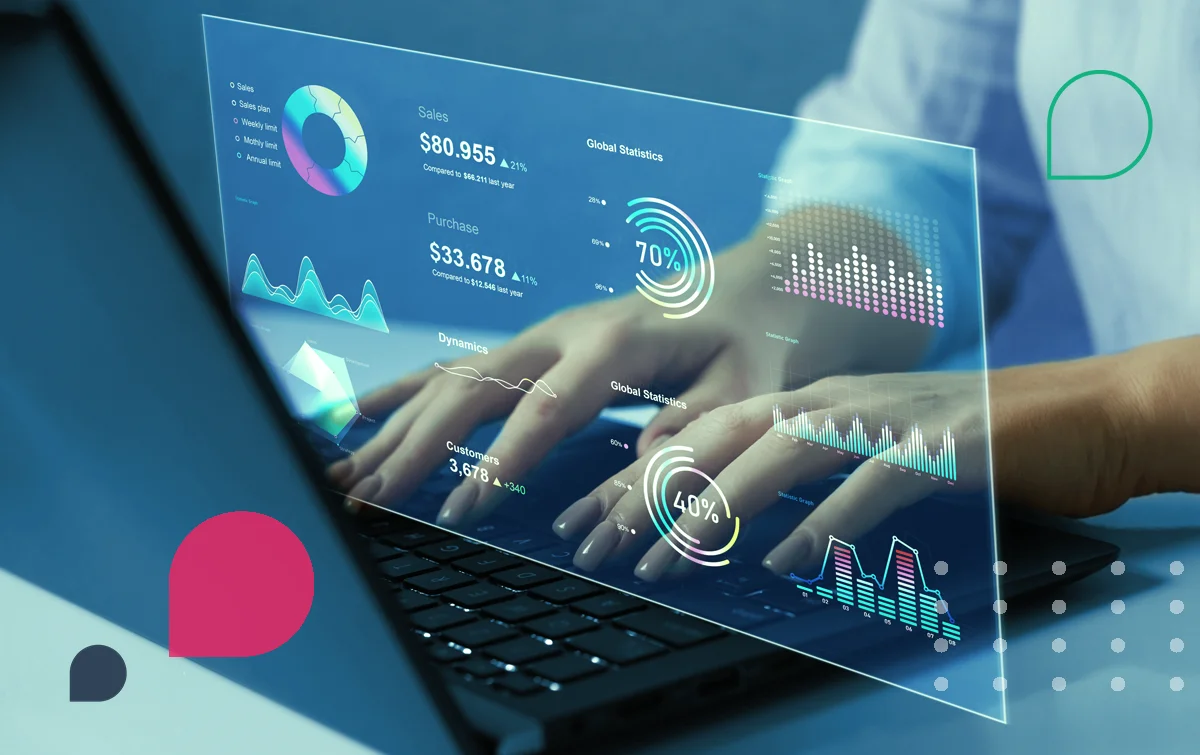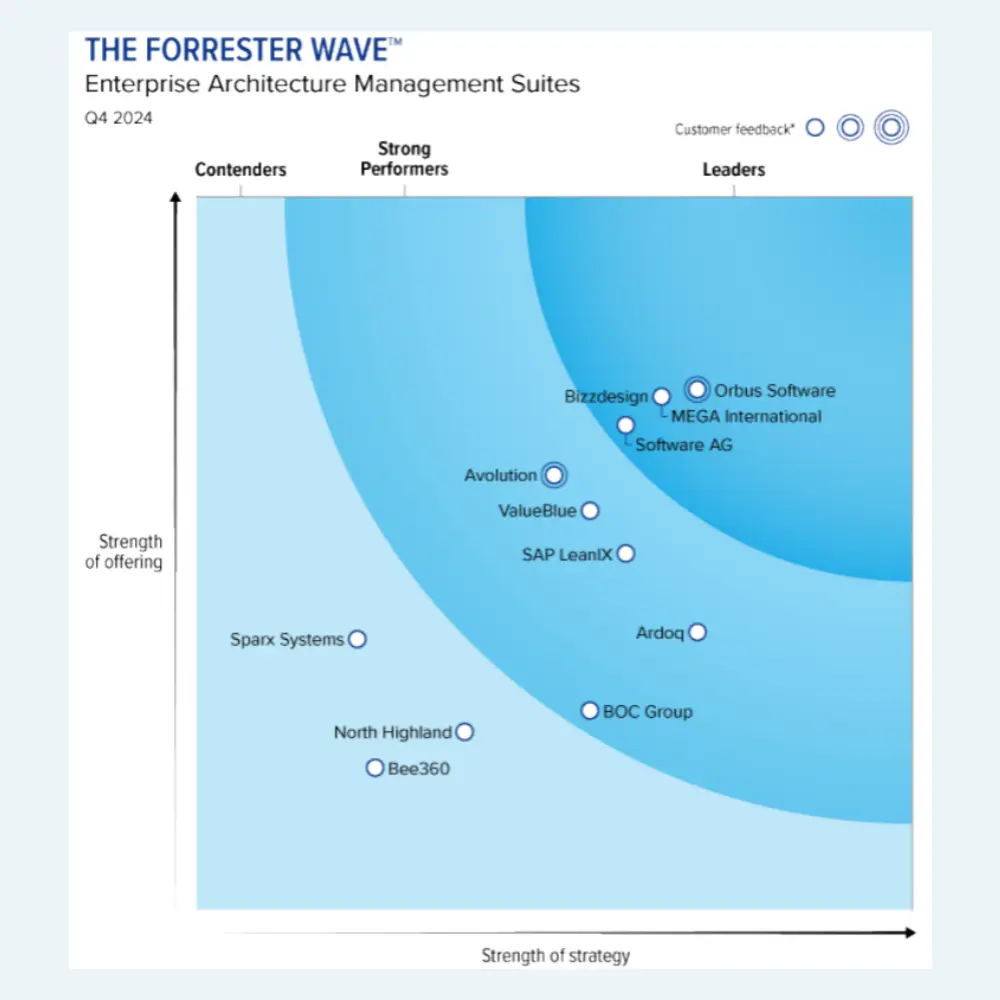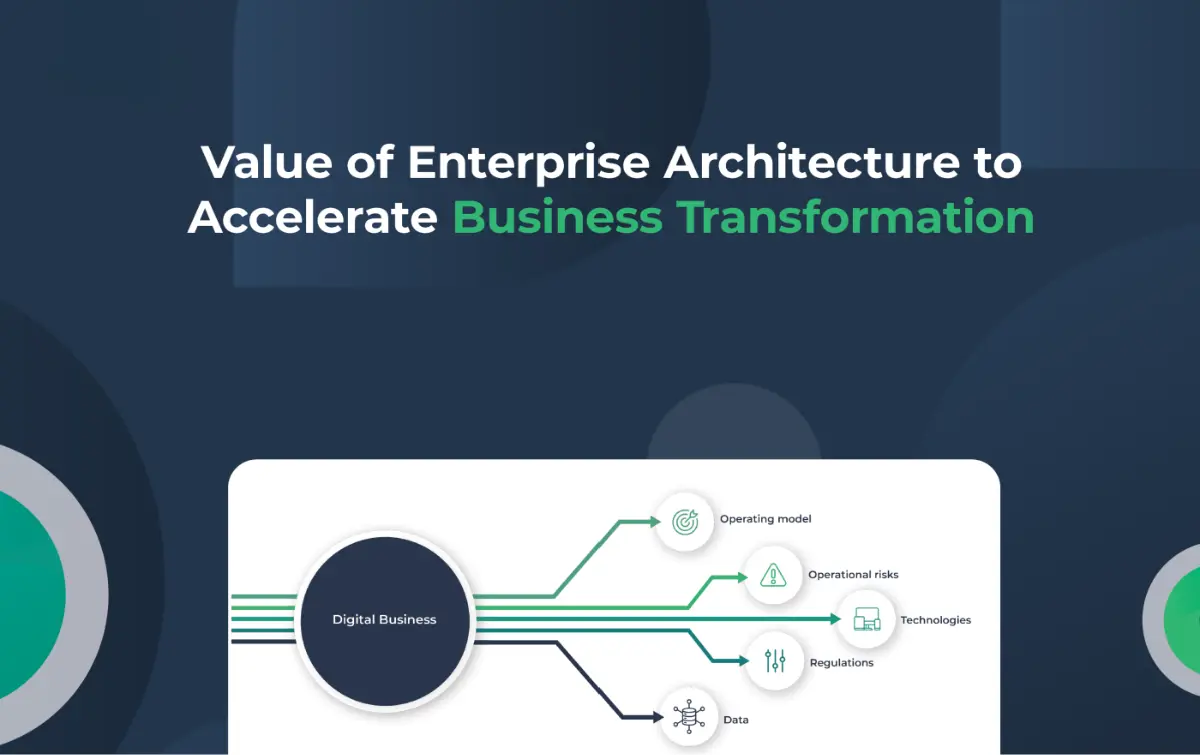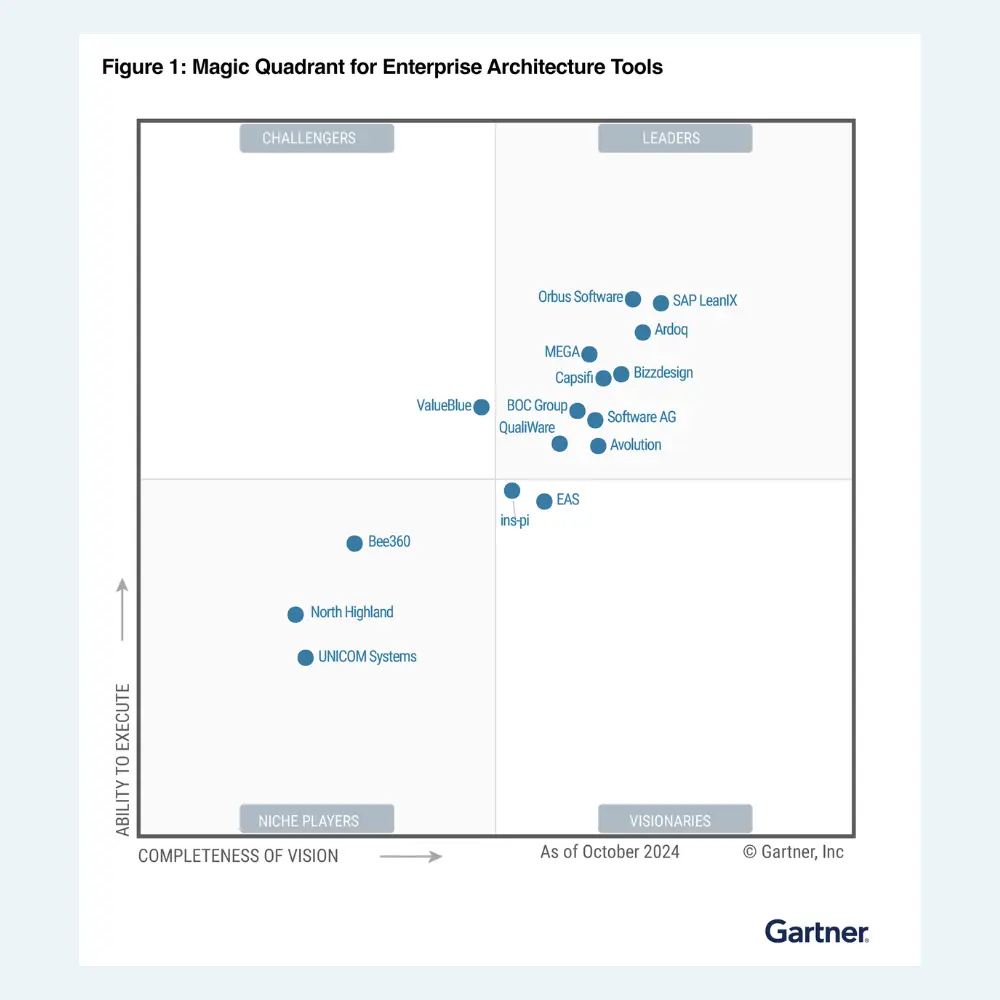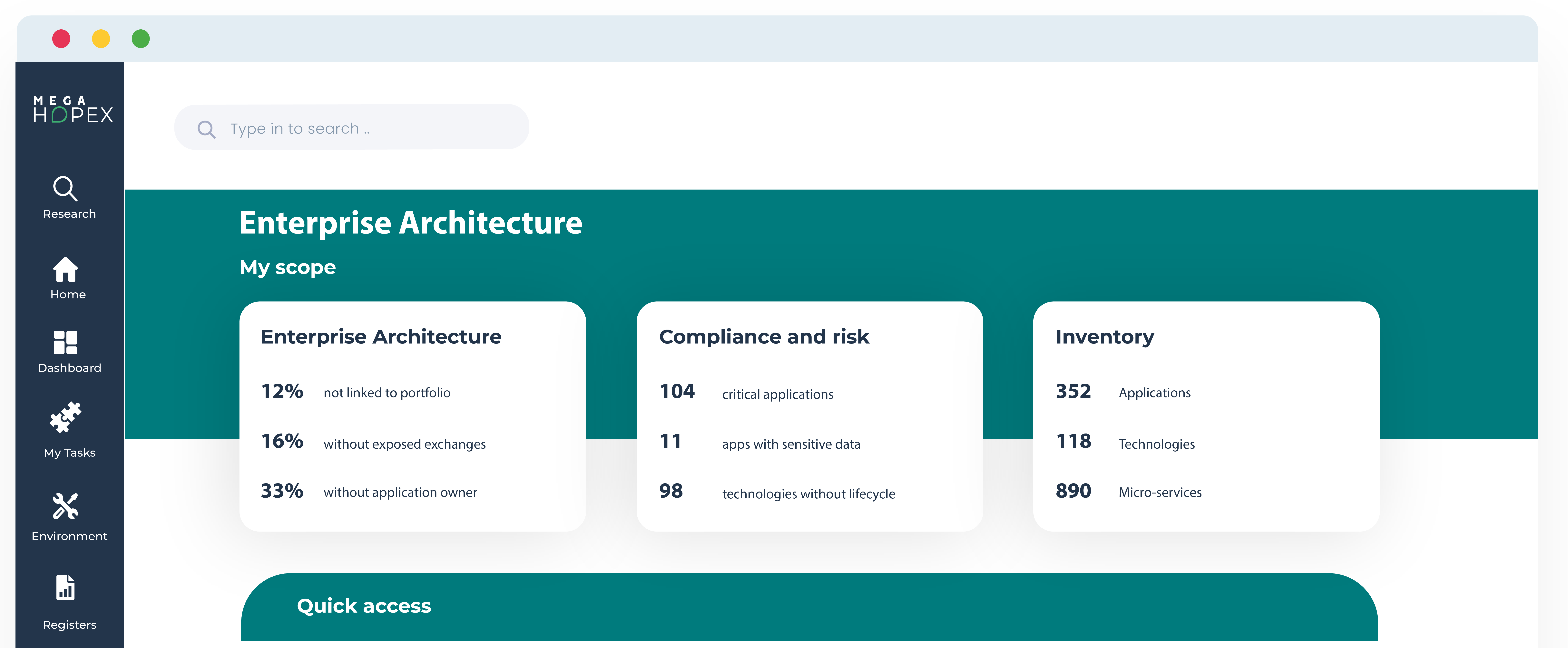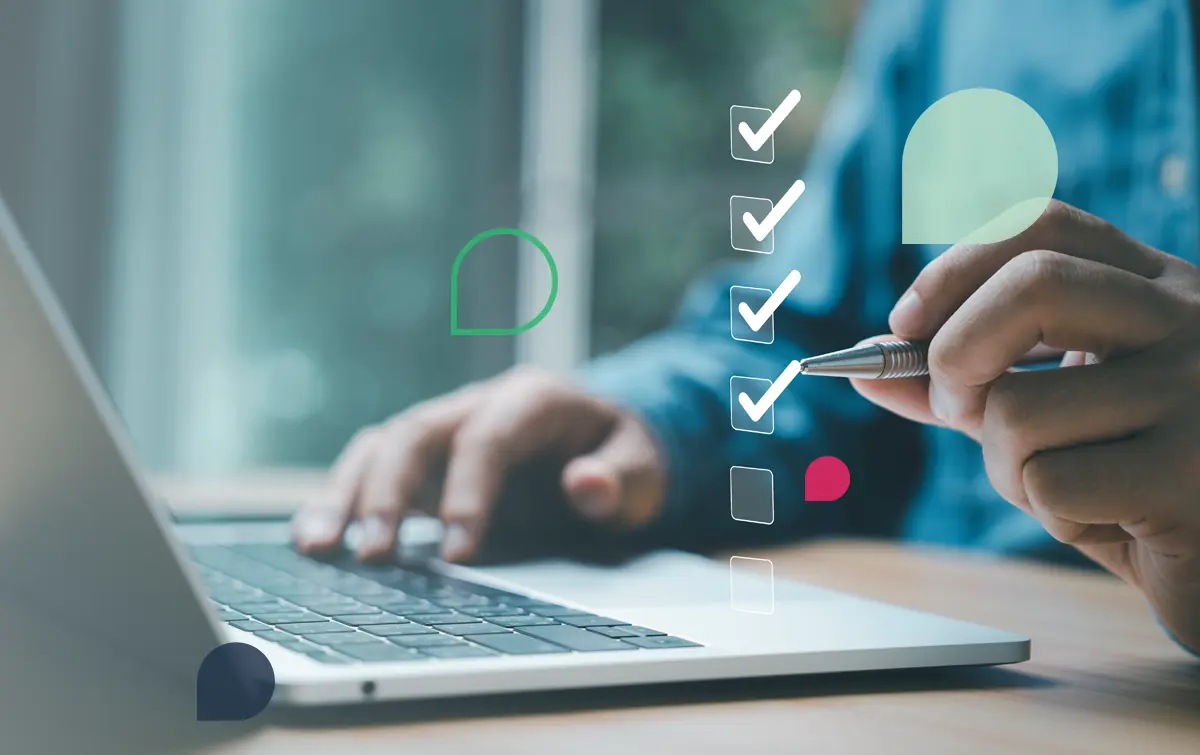
Application Modernization Introduction and Best Practices
Application modernization has become essential for businesses across industries to stay competitive in an increasingly digital world. With advancements in technology, the way businesses approach their applications has changed.
In the past, applications were developed as monolithic systems that were difficult and time-consuming to modify or update. However, with modernization, applications are broken down into smaller, more manageable components that can be updated quickly and easily.
Now, let's learn about the importance of application modernization for businesses and how it can help drive innovation, reduce costs, and enhance customer satisfaction. We will also discuss the best practices for successful application modernization and how to overcome common challenges.
What is Application Modernization?
Application modernization is the process that involves updating and improving existing software applications to meet business needs and technology standards.
Modernization involves migrating legacy systems to new platforms, redesigning user interfaces to enhance user experience, and optimizing applications to improve performance and scalability. The primary goal of modernization is to ensure that applications are reliable, secure, and cost-effective.
Modernization may also allow organizations to take advantage of new features and functionality provided by the latest technologies. It involves evaluating the core business processes and the application's support and determining the requirements for the updated software.
Several approaches to application modernization exist, including reengineering, migration, and replacement. Reengineering involves enhancing the existing application while maintaining its primary functionality.
Migration involves moving application data and processes to newer platforms or architectures. Replacement consists of replacing legacy systems with new software developed from scratch or with SaaS solutions.
Benefits of Application Modernization: Why You Should Consider It
Application modernization is revamping and updating outdated software applications to make them more efficient, reliable, and compatible with modern technologies.
Several benefits of application modernization can make it worth considering for your business. Here are some of the main advantages
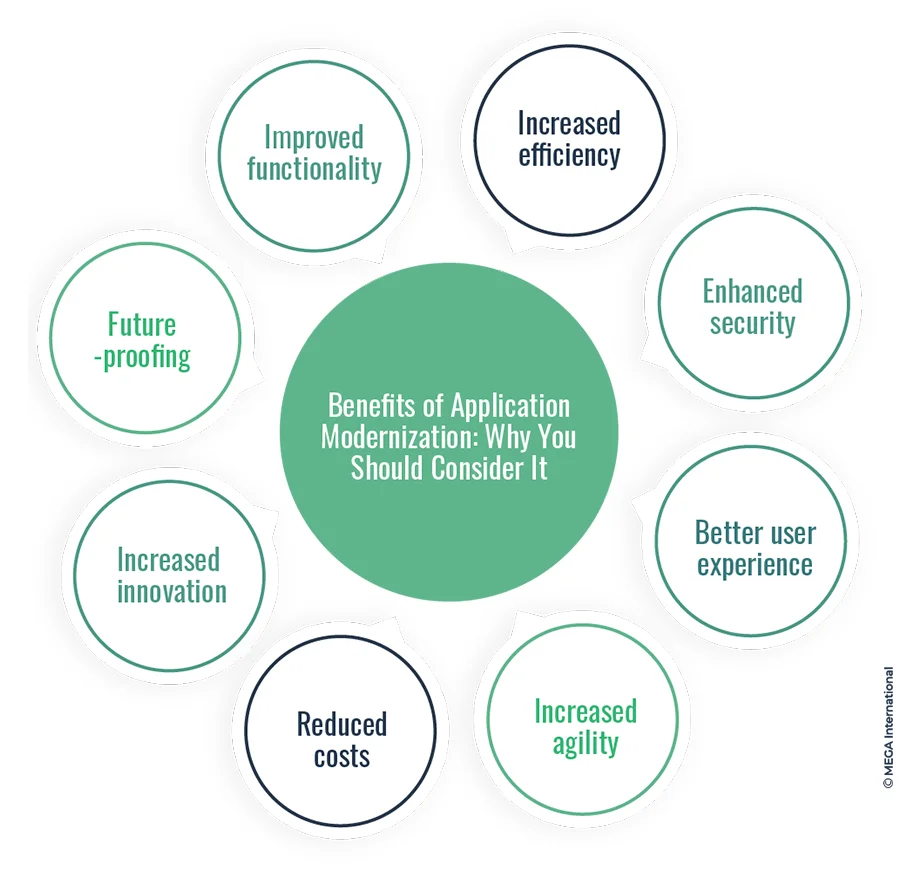
Improved functionality:
One of the most significant benefits of application modernization is that it can improve the functionality of your software. This can be achieved by adding new features, removing outdated ones, and streamlining processes. The result is a more practical application that can better meet your business's and customers' needs.
Increased efficiency:
Modernizing your applications can also significantly increase their performance, speed, and scalability efficiency. Updating your software allows you to use new technologies that make your applications run faster and more smoothly. This can lead to improved productivity and cost savings for your business.
Enhanced security:
Another critical benefit of application modernization is improved security. Updating your software can ensure it is up-to-date with the latest security patches and protocols, protecting your business and its data from cyber threats.
Better user experience:
Modernizing your applications can also improve the user experience (UX), making it easier and more intuitive for your customers to interact with your software. This can increase customer satisfaction, loyalty, and, ultimately, higher revenue.
Increased agility:
Finally, application modernization can increase your organization's agility, allowing it to respond more quickly and effectively to changing market conditions, customer needs, and industry trends.
By updating your software and adopting new technologies, you can stay relevant and keep ahead of the competition. In conclusion, modernizing your software applications can provide many benefits, including improved functionality, efficiency, enhanced security, better user experience, and agility.
Reduced costs:
Modernizing applications is a crucial step for businesses to reduce maintenance costs. By upgrading outdated applications, companies can eliminate issues arising from old technologies, reduce the resources needed to maintain older applications, and optimize performance.
The latest technologies and development platforms can help businesses automate IT operations and create more efficient business processes.
Additionally, the newest application architectures, such as microservices and containers, encourage developers to work more flexibly, allowing them to update and change applications more quickly.
This reduces the time and resources needed to maintain applications, allowing businesses to reallocate these resources to more impactful endeavors.
Increased innovation:
Modernizing applications can bring businesses a plethora of benefits. Organizations can leverage the latest developments, such as cloud computing, artificial intelligence, and machine learning, by updating their technology stack to streamline their processes and gain a competitive advantage.
For instance, cloud computing allows businesses to store their data securely and scale up or down their infrastructure as required.
Similarly, AI and machine learning enable companies to gain insights from vast amounts of data, automate tasks, and reduce errors. Modernizing applications also empowers businesses to innovate faster and promptly respond to changing market conditions.
Future-proofing
Businesses must keep up with the latest trends to remain competitive. However, with the ever-increasing technological advancement, businesses need to modernize their applications. By doing so, they can ensure that their companies are adaptable and quickly respond to changing customer needs.
How Can HOPEX Assist in Application Portfolio Modernization?
HOPEX platform offers a range of solutions for enterprise architecture, business process analysis, and other aspects of IT and business management. When it comes to application modernization, HOPEX assists in several ways:
- Assessment and Analysis: HOPEX provides tools for assessing your current application portfolio. It can help you analyze the existing applications, their dependencies, technologies, and business relevance. This analysis is crucial in identifying which applications are prime candidates for modernization.
- Strategic Planning: After assessing your application portfolio, HOPEX can aid in the strategic planning phase. It helps organizations define their modernization objectives and align them with business goals. You can create roadmaps and prioritize which applications to modernize based on ROI, risk, and strategic importance.
- Collaboration and Communication: Application modernization often involves multiple teams and stakeholders. HOPEX offers collaboration and communication features that allow different departments to work together seamlessly. This helps streamline the modernization process and ensures everyone is on the same page.
- Architecture Design: HOPEX provides modeling and design capabilities to help you create blueprints for modernized applications. You can design the target architecture, including microservices, APIs, and data models, ensuring that your modernized applications are scalable and flexible.
- Governance and Compliance: HOPEX can help ensure that your modernization efforts comply with regulatory requirements and internal policies. It helps track changes, manage risks, and maintain documentation, which is crucial in regulated industries.
- Change Management: Modernization involves significant technological changes, processes, and roles. HOPEX can support change management by providing tools for documenting and communicating changes and tracking their impact on the organization.
- Monitoring and Optimization: HOPEX can help monitor their progress and performance once modernization projects are underway. It allows you to track key performance indicators (KPIs) and adjust as needed to optimize the modernization process.
- Knowledge Management: HOPEX can serve as a repository for knowledge related to your application modernization initiatives. It stores information about architecture decisions, best practices, and lessons learned, making it easier for teams to leverage past experiences.
- Integration: HOPEX can integrate with other tools and systems used in your organization, such as DevOps tools, project management software, and IT service management systems. This integration streamlines data exchange and coordination between different teams and processes.
HOPEX can play a vital role in the application modernization journey by providing tools and capabilities for assessment, planning, design, governance, collaboration, and monitoring. It helps organizations streamline their modernization efforts, align them with business goals, and meet compliance and performance requirements.
Challenges of Application Modernization
Application modernization is essential for businesses looking to stay competitive and meet customers' evolving needs. However, modernizing legacy applications can be a complex and challenging process that presents a range of obstacles for businesses.
Many factors can hinder successful application modernization, from identifying the right technologies to managing data migration and ensuring security.
Here are some common challenges associated with application modernization:
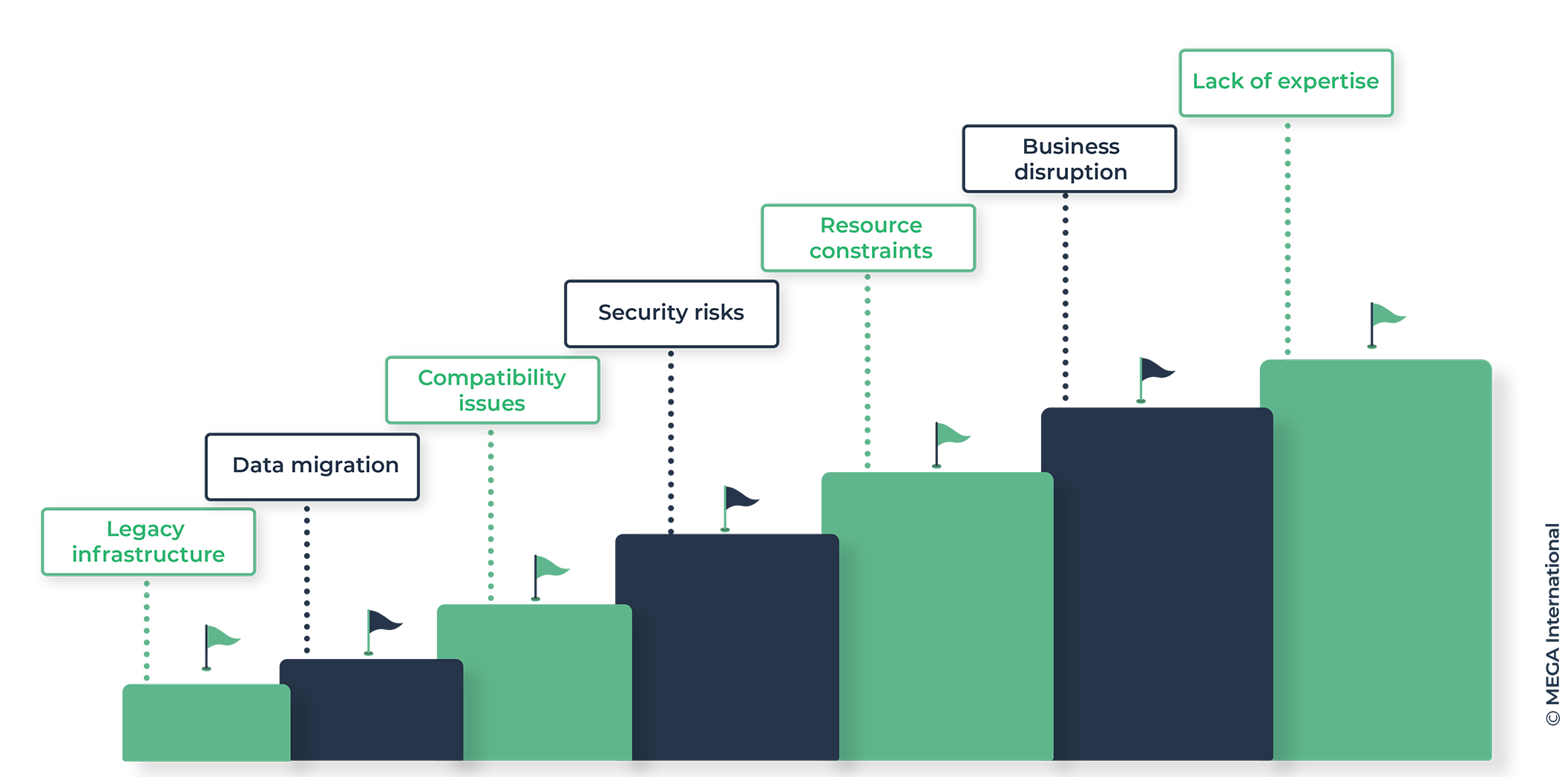
- Legacy infrastructure: Legacy systems are often complex and outdated, making it challenging to modernize applications without disrupting existing operations.
- Data migration: Migrating data from legacy systems to modernized applications can be time-consuming and complex, requiring careful planning and execution.
- Compatibility issues: Modernizing applications can create compatibility issues with other systems, resulting in integration challenges and affecting overall performance.
- Security risks: Modernized applications can present new security risks that must be addressed to protect against cyber threats and data breaches.
- Resource constraints: Modernizing applications can require significant investments in time, money, and resources, which can strain business budgets and resources.
- Business disruption: Modernizing applications can cause significant disruption to existing operations, which can impact business continuity and customer satisfaction.
- Lack of expertise: Application modernization requires specialized skills and knowledge, which may not be available in-house, leading to delays and increased costs.
When businesses recognize these challenges and take steps to overcome them, they can effectively modernize their applications and reap the rewards of enhanced functionality, increased security, and more significant innovation.
Application Modernization Strategy
Application modernization strategy refers to updating or upgrading existing software applications to enhance their functionalities, efficiency, and overall user experience. The primary reason for application modernization is to improve the application's performance and functionality and keep up with the rapid pace of digital transformation.
Business users expect software to be accessible through various devices, platforms, and operating systems, which legacy applications often cannot serve. The modernization strategy focuses on enabling these applications to work with the latest tools and trends in the industry.
The first step toward an application modernization strategy is understanding its current state. This involves identifying resource usage trends and cross-functional intricacies and assessing end-user feedback on the application experience.
Once you clearly understand where your application stands today, you can create a roadmap to get you to where you need to be in the future. The strategy must be aligned with your business goals, and you should have a clear vision of what matters most to your organization.
All project stakeholders should be involved in this visioning process to ensure they understand the final goal. An application modernization strategy may involve upgrading software architecture or redesigning modern platforms.
The strategy must balance the benefits of modernization against the risks and costs of the proposed changes. This typically involves weighing the short-term advantages of improvements against the effort required to make those improvements. The strategy should ensure that data is migrated accurately and that new processes and procedures are introduced seamlessly into the application environment.
Keeping the application simple and user-friendly is also vital to satisfy end-users. Most importantly, modernization should be carried out continuously. Regular updates must be made to keep the application up-to-date, and all stakeholders must remain involved throughout the modernization process.
Finally, a good application modernization strategy must ensure that end-users' needs are met while keeping the organization in mind. It must be understood as a long-term investment, with each iteration bringing the application closer to its ultimate goal of improved performance and functionality.
Best Practices for Successful App Modernization
To ensure a successful application modernization process, businesses should follow these best practices:
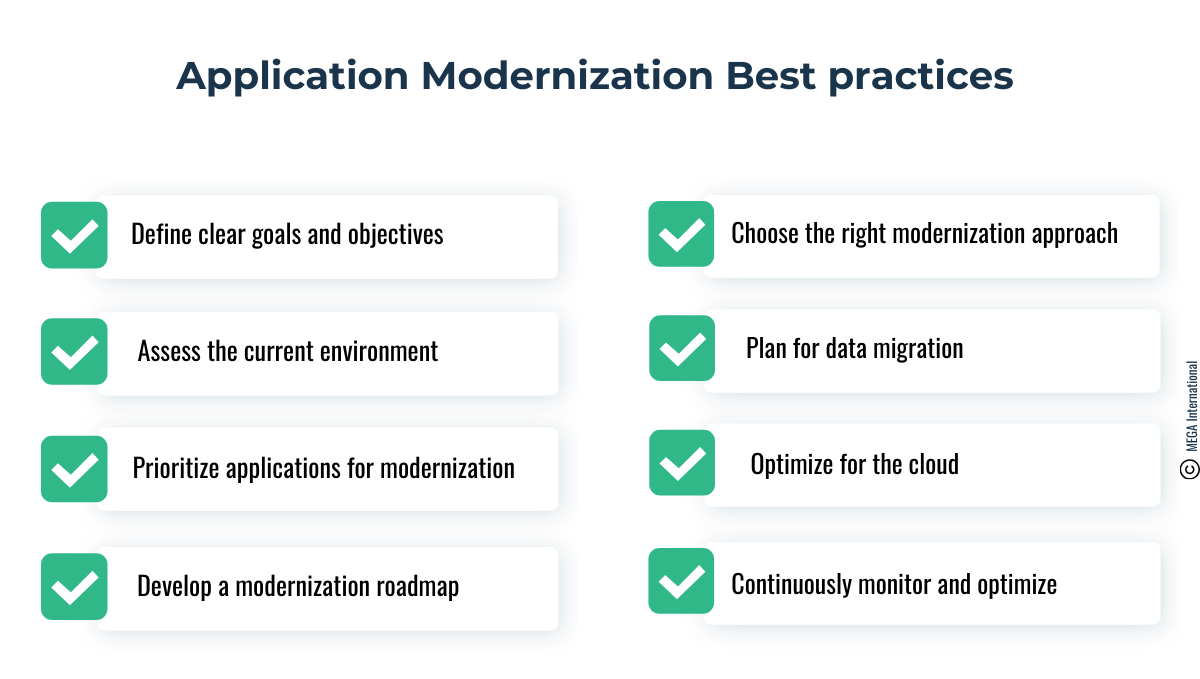
- Define clear goals and objectives: Establish goals and objectives for the modernization process, including performance improvements, cost savings, and enhanced security.
- Assess the current environment: Conduct a thorough assessment of the existing environment, including the application portfolio, infrastructure, and security posture.
- Prioritize applications for modernization: Prioritize applications for modernization based on their criticality, business value, and technical complexity.
- Develop a modernization roadmap: Develop a comprehensive roadmap that outlines the modernization process, including timelines, milestones, and deliverables.
- Choose the right modernization approach: Choose the one that aligns with your business goals, such as a lift-and-shift, re-platforming, or re-architecting.
- Plan for data migration: Develop a plan for data migration that considers data security, integrity, and compliance requirements.
- Optimize for the cloud: Optimize applications for the cloud to take advantage of cloud-native services and improve scalability and reliability. Test the modernized applications thoroughly to ensure they meet performance, security, and user experience requirements.
- Continuously monitor and optimize: Continuously monitor and optimize modernized applications for performance, security, and scalability.
Calculating the ROI of IT Modernization
ROI analysis is a critical step in determining the potential value of IT modernization for a business. Businesses can make informed decisions about whether to invest in modernizing their technology systems by quantifying the expected costs and benefits.
One key component of an ROI analysis is estimating the initial investment required for modernization, which includes the cost of hardware, software, personnel, and training. This can be challenging, as there are often hidden costs associated with modernization that may take time, such as retraining employees or upgrading existing infrastructure to support new technology.
In addition to identifying modernization costs, businesses must also estimate the expected returns from the investment. These may include productivity gains, cost savings from reduced maintenance and support costs, increased revenue from new business opportunities, and improved customer satisfaction.
Estimating the returns can also be challenging, as some benefits may be intangible and difficult to quantify. However, by developing a comprehensive ROI analysis, businesses can better understand the potential value of IT modernization and make informed decisions about their technology investments.
ROI analysis can also help businesses identify potential risks associated with IT modernization. For example, some modernization projects may have a more extended payback period or require significant upfront investment, which could impact short-term cash flow.
There may also be operational risks associated with modernization, such as potential disruption to existing business processes or difficulty integrating new technology with existing systems. Businesses can develop strategies to mitigate these risks and ensure a successful modernization project by identifying them.
Essential Tools and Technologies for IT Modernization
Adopting essential tools and technologies is a critical aspect of successful IT modernization. Cloud computing, artificial intelligence, the Internet of Things (IoT), and blockchain are vital modernization solutions businesses should consider.
Cloud computing, for example, offers businesses unmatched scalability and infrastructure flexibility that can help them cut costs.
Conversely, AI provides automation in IT infrastructure, allowing it to deal with repetitive tasks and consolidate data. This saves time and money and reduces the risk of costly human errors.
Modernization efforts can also benefit from DevOps tools such as containerization technologies like Docker and Kubernetes, which, combined with Infrastructure as Code, enable consistent deployment of applications across environments, facilitating repeatable and reliable deployments to production environments that can be delivered with agility and confidence.
Get a complimentary copy: 2024 Gartner® Magic Quadrant™ for Enterprise Architecture Tools
Summary
Application modernization is a crucial process that businesses must consider to keep up with the ever-changing technological landscape. Modernizing legacy applications can help organizations to streamline processes, increase efficiency, and reduce costs.
This process involves many activities, such as re-engineering the architecture, updating code, and migrating data to more modern systems.
While modernizing applications can be complex and time-consuming, keeping up with the digital demands of the contemporary business environment is imperative. With the right approach, application modernization can help to future-proof an organization, providing a solid foundation for continued growth and success.
Businesses should invest in application modernization to stay ahead of the curve and relevant in their industry.
FAQs
Application modernization is updating and improving existing applications to ensure they function more effectively, are optimized for modern use cases, and remain relevant over time. This process enables organizations to keep pace with changing business demands and technology advancements while maintaining and extending the value of their existing application portfolio.
Organizations that need to modernize their applications risk becoming outdated, inefficient, and uncompetitive. By updating their applications, businesses can accelerate the development and delivery of critical services, improve agility, and reduce technical debt. Additionally, application modernization helps organizations utilize the cloud platform, migrate to newer architectures, and adopt microservices.
Application modernization strategies can vary depending on an organization's specific needs and goals. However, some common approaches include rehosting, refactoring, and building modern applications. Rehosting involves moving existing applications to a cloud platform, while refactoring involves updating the code and architecture of existing applications to optimize them for new environments.
Modernizing legacy applications can be daunting, but keeping up with the rapidly changing technology landscape is essential. One way to update legacy applications is to move them to the cloud. This approach can offer several benefits, such as reducing maintenance costs, improving scalability, and increasing flexibility. Another option is to re-architect or refactor the application, making it more modular and scalable. This can involve breaking the monolithic application into smaller microservices, allowing for greater agility and individual scalability. Another popular modernization option is containerizing legacy applications using technologies such as Docker or Kubernetes.
The value of Enterprise Architecture to accelerate business transformation
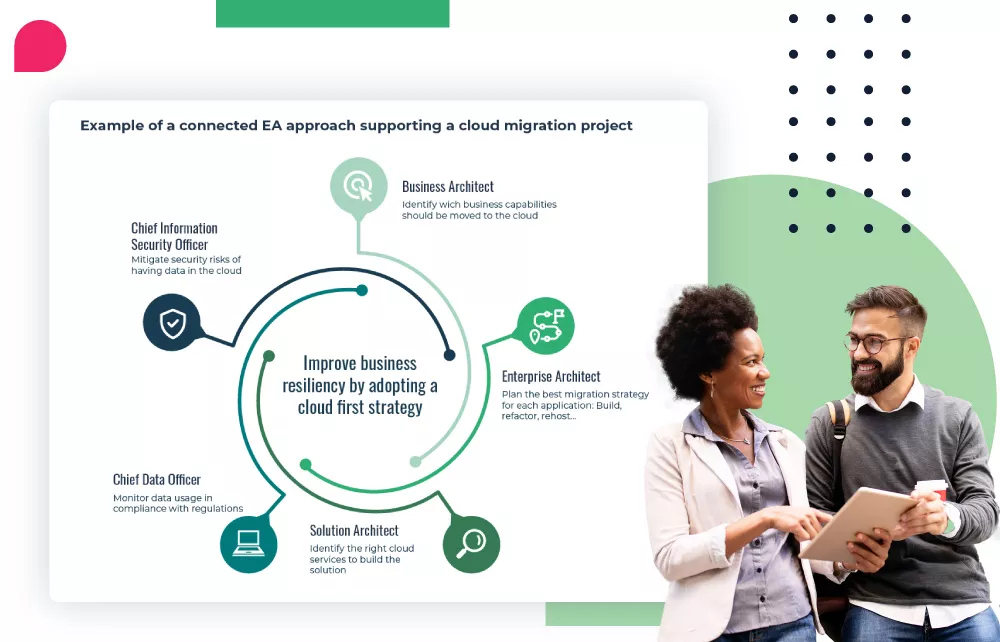
Access this white paper to learn:
- The evolution of the enterprise architecture practice
- How to Deliver Value through a Connected Enterprise Architecture Practice
- Strategies for Adopting a Business-Outcome-Driven Approach
- How to Use Data-Driven Tools to Enhance Your Enterprise Architecture Connectivity
Enterprise Architecture Related Content
Shift from a documentation tool to an operational tool and accelerate business transformation
MEGA HOPEX for Enterprise Architecture
Request a demonstration of HOPEX for EA, and see how you can have immediate value of your projects.







